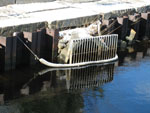Contemporary Urban Waterscapes
designing
public spaces in concert with nature
How can we begin to restore water quality in our cities? Considering that increasing people's awareness of how water is used and replenished is fundamental to the future stewardship of our natural resources, especially among younger generations, it would be beneficial if as urban designers and planners we could re-establish the hydrologic cycle in a way that also brings water to the surface and makes it something with which people can engage and interact. So, how can we create places that "exploit the aesthetic properties of water without wasting it." (Spirn 1984, 163)? How can we design places that both collect and treat runoff before it is discharged back into the watershed and that offer people opportunities to experience water as a cultural, natural and physical generator of life? This site looks at "waterscapes" (Dreiseitl) as projects that embrace both natural and cultural processes to create public spaces that prioritize the role of water in our urban systems and allow people to experience water in numerous ways. The cases I examine are: Potsdamer Platz, Berlin by Atelier Dreiseitl as an early example of waterscape project; the Lurie Garden in Millennium Park, Chicago by Gustafson Guthrie Nichol (GGN) as a recent example of a waterscape project and proposals from GGN and Dreiseitl for the Canal Park in Washington D.C. as a comparison of each firm's approach to a given site.
|
Water from the Broad Canal in Cambridge, MA is piped underground when it reaches the dense, commercial area around Kendall Square. Photograph by Francisca Rojas
Adequate treatment and disposal of wastewater contributes to better ecosystem conservation and less pressure on scarce freshwater resources. Careful use of water resources prevents contamination of groundwater and helps minimize the cost of water treatment. (WHO/UN-Water 10) |
||||||||||
